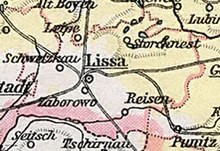Lissa district

The district of Lissa on the southern edge of the Prussian province of Posen existed from 1887 to 1920. The former district area today belongs to the Polish Voivodeship of Greater Poland .
expansion
The Lissa district had an area of 525 km².
prehistory
After the Second Partition of Poland from 1793 to 1807, the area around the city of Lissa belonged to the Prussian province of South Prussia . After the Peace of Tilsit , the area became part of the Duchy of Warsaw in 1807 . After the Congress of Vienna on May 15, 1815, the area again fell to the Kingdom of Prussia . Until October 1, 1887, it belonged to the Fraustadt district in the Posen Province .
Administrative history
On October 1, 1887, a separate Lissa district was formed from the eastern part of the Fraustadt district.
Came to the new Lissa County
- the cities of Lissa , Reisen , Schwetzkau , Storchnest and Zaborowo ,
- the Lissa police district (excluding the rural community of Neu Laube) and
- the Storchnest Police District.
Lissa became the district town and seat of the district administration .
On December 27, 1918, the Wielkopolska uprising of the Polish majority against German rule began in the province of Posen , and by January 1919 the north-east of the district around the town of Storchnest was under Polish control. The southwest of the district, including the cities of Lissa and Reisen, remained under German occupation.
On February 16, 1919, an armistice ended the Polish-German fighting, and on June 28, 1919, the German government officially ceded the Lissa district to newly founded Poland with the signing of the Treaty of Versailles . On November 25, 1919, Germany and Poland concluded an agreement on the evacuation and surrender of the areas to be ceded, which was ratified on January 10, 1920.
The evacuation of the remaining area under German control including the district town Lissa and handover to Poland took place between January 17 and February 4, 1920. The Lissa district became the Polish powiat Leszczyński .
In addition, the neighboring communities Neu Laube, Scharne, Weine and Wilhelmsruh, which also came to the Powiat Leszczyński, were ceded from the Fraustadt district.
Population development
| year | Residents | source |
|---|---|---|
| 1890 | 38,980 | |
| 1895 | 39,418 | |
| 1900 | 40,313 | |
| 1910 | 44,579 |
Of the district's residents in 1890, about half were Polish and half German as their mother tongue. Most of the Germans lived in the district town of Lissa (almost 14,000 people or 86% of the city's population). After 1920, part of the German population left the area.
politics
District administrators
- 1887–1893 Hans von Hellmann (1857–1917)
- 1893–1898 Fink ( representative )
- 1898–1907 Arnold von Rosenstiel (1864–1926)
- 1908–1920 Siegfried von Kardorff (1873–1945)
elections
The Lissa district together with the Fraustadt district formed the Posen 6th Reichstag constituency . In the Reichstag elections between 1887 and 1912, the following members were elected:
- 1887 Paul von Rheinbaben , Free Conservative Party
- 1890 Hans von Hellmann , Free Conservative Party
- 1893 Stanislaus von Chlapowski , Polish parliamentary group
- 1898 Anton Tasch , Center Party
- 1903 Karl Schmidt , Free Conservative Party
- 1907 Max Kolbe , Free Conservative Party
- 1912 Hans Georg von Oppersdorff , Center Party
Municipal structure
On January 1, 1908, the Lissa district included the cities of Lissa, Reisen, Schwetzkau and Storchnest. The remaining (as of 1908) 55 rural communities and 35 manor districts were combined into police districts.
Communities
At the beginning of the 20th century the following communities belonged to the district:
|
With a few exceptions, the Polish place names continued to apply after 1815, and several place names were Germanized at the beginning of the 20th century.
See also
literature
- Martin Sprungala : The history of the Poznan districts and independent cities. Bad Bevensen 2007.
- Martin Sprungala: Historical Directory of the Province of Poznan and the Poznań Voivodeship (Poznan). Bad Bevensen 2007.
Web links
- Lissa district administrative history and the district administrators on the website territorial.de (Rolf Jehke), as of August 18, 2013.

